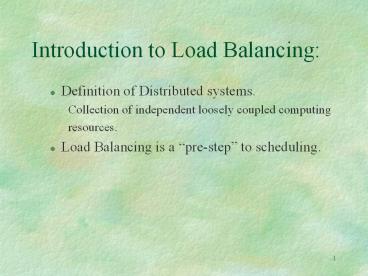Introduction%20to%20Load%20Balancing: - PowerPoint PPT Presentation
Title:
Introduction%20to%20Load%20Balancing:
Description:
De-Centralized Load balancer: Advantages: No Single point of failure. ... Decide the granularity of Load Balancer. Different types of resources. 10 ... – PowerPoint PPT presentation
Number of Views:62
Avg rating:3.0/5.0
Title: Introduction%20to%20Load%20Balancing:
1
Introduction to Load Balancing
- Definition of Distributed systems.
- Collection of independent loosely coupled
computing - resources.
- Load Balancing is a pre-step to scheduling.
2
Motivations
- Random Arrival of user tasks.
- Varied Computing resources of different hosts.
- Homogeneous Vs Heterogeneous systems.
3
Basic Issues
- Definition of LOAD and Performance as the basics
of Load Balancing. - Criterion for Load Balancing
- Process based factors.
- Resource based factors.
- Algorithmic factors.
- Efficient Evaluation of these criterion.
4
Load Balancing Vs Sharing
- Both attempt to maximize response time.
- Balancing implies that load has to equalized
rather than just shared. - Hence Load Balancing is a special Case of Load
Distribution policy. - Load Balancing has more over head.
5
Load Balancing ArchitecturesCentralized Load
Balancer
6
Centralized Load Balancer
- Advantages
- Single Host Implementation.
- Highly adaptive.
- No Overhead on individual hosts.
- Better State Consistency.
- Centralized transfer of tasks.
- Disadvantages
- More expensive.
- Single point of failure.
- Relatively lesser scalable.
7
Load Balancing ArchitecturesPeer to Peer
Architecture
8
De-Centralized Load balancer
- Advantages
- No Single point of failure.
- Independent unit of operation for each host.
- Highly scalable.
- Disadvantages
- Complex implementation.
- Overhead on each host due to load of the
algorithm. - Lesser level of adaptability to heterogeneous
environments.
9
Peripheral Components
- Client Programs
- No knowledge of location of execution i.e.
Location Transparency. - Priority, type of process may influence Load
Balancing decisions. - Resources
- Decide the granularity of Load Balancer.
- Different types of resources.
10
Peripheral Components
- Status of resources collection mechanisms.
- Broadcast.(periodic, demand driven, state
change) - Kernel based monitor. (periodic, demand driven,
state change) - Publish - Subscribe Model.
11
Peripheral Components
- Communication network
- Speed, reliability adaptability issues.
- Hetrogeneous requirements for networks.
12
Load balancing Details
- Load Balancing policies
- Static
- Dynamic
- Adaptive(Learning)
- Non-Adaptive.
13
Load Balancing details
- Load Performance Metrics
- Load Index of CPU Queues, CPU utilization etc.
- Performance Measured as an index of average
response time for client processes.
14
Load balancing Details
- Type of task transfers
- Preemptive
- Process Migration required.
- Generally more over head involved as the entire
process state is transferred. - Non-Preemptive
- Based on initial task placement.
- Simpler more efficient.
15
Load Balancing Details
- Composition of an Load Balancing Algorithm
- Transfer policy Determines the state of a node
I.e sender or receiver. - Selection policy Determines which task would
be transferred. - Location policy where to transfer.
- Information policy State maintanence.
16
Load Balancing Details
- Stability of a Load Balancing Module
- Algorithmic stability.
- System stability.
- In effective Vs effective algorithms.
- Stability Effectiveness of a Load Balancing
Algorithm.
17
Conclusion
- Load balancing forms an important strategy for
the improvement of the average response time for
any user process. - Internet as a major boost for its application.
- Load balancing widely used as a major component
of clustered solutions. - Advances in technologies relating to peripheral
components leads to more focus on efficient
implementation of the load Balancing Algorithm.































